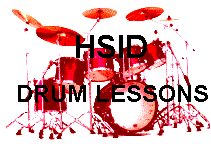Downloads *
Drummers Trivia *
Drummers Chat Rooms *
Rudiments *
Digital Music *
Knowledge Assessments *
TD Archives *
Drum Set Buyers Guide *
Bass-Player Jokes *
Assembling a Drum Set *
Parts of a Drum Set *
About HSID *
Video Troubleshooter
Bill Powelson's School of Drums
School of Drums
PRIVATE DRUM LESSON 12 E-M
"Classic Jazz Waltz Based on Swing"
Copyright 1998 Bill Powelson all rights reserved

Classic Jazz Waltz
As we learned in the first Waltz lesson, there are over 5 Quintillion possible variations
or Permutations of the 3/4 Waltz beat. Of those phenomenal numbers, one specific
variation has re-surfaced time and time again in pop music trends. This is the syncopated Swing Waltz, made popular by many jazz artists from Dave Brubeck to
Art Blakey.
We will start with a simple Swing Waltz then stair-step or graduate slowly into some of the more complex forms of the rhythm.
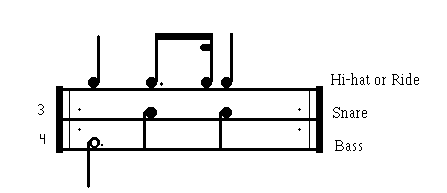
 This is a simple Swing Waltz.
You may hear it most often with simple C&W tunes or many soft romantic, pop-ballads.
This basic pattern is a total bore for most drummers, though it is the one we wind up being forced to play most often.
This is a simple Swing Waltz.
You may hear it most often with simple C&W tunes or many soft romantic, pop-ballads.
This basic pattern is a total bore for most drummers, though it is the one we wind up being forced to play most often.
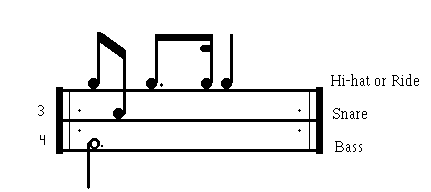
 Now, we toss in a quick syncopation on the snare, in-between the 1st and 2nd cymbal notes. We
are leading up to something a little more interesting.
Now, we toss in a quick syncopation on the snare, in-between the 1st and 2nd cymbal notes. We
are leading up to something a little more interesting.
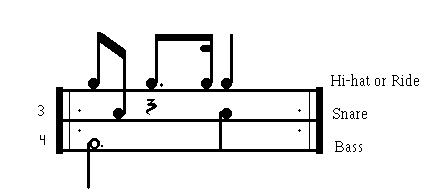
 This is the most basic and most common form of syncopated Swing 3/4 or Jazz Waltz.
This is the most basic and most common form of syncopated Swing 3/4 or Jazz Waltz.
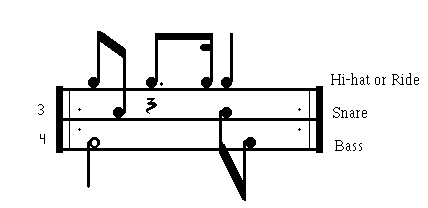
 There are many ways to vary the beat. Here is an example showing an additional bass note with each repetition.
.
There are many ways to vary the beat. Here is an example showing an additional bass note with each repetition.
.
JAZZ WALTZ is unique in that every 6/8 Blues beat could conceivably contain
two repetitions of waltz. It is very common for jazz musicians to build interesting arrangements based on this principle. You will hear many jazz tunes that jump
or shift from Blues into Jazz Waltz and back while maintaining the same general tempo.
 MIXING BLUES & JAZZ WALTZ: This sound file will give you the idea.
MIXING BLUES & JAZZ WALTZ: This sound file will give you the idea.
FILLS: When dropping fills into the above Jazz Waltz pattern it may be best to
begin your fills on the 1st count of the measure as you are learning. Use any roll pattern you wish. Play three groups of your roll beginning on the first count of the bar.
This will bring you out to the first count of the next bar. Later, you may experiment
with dropping fills on the 2nd or 3rd count in the measure. It really doesn't matter
what you play as a fill, nor where you begin. The trick is to never lose track of the count.
 VIDEO: Click here to 'Play', see, and hear a short solo using the tips in this lesson.
VIDEO: Click here to 'Play', see, and hear a short solo using the tips in this lesson.

Copyright Bill Powelson 1996 all rights reserved.


